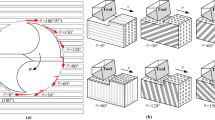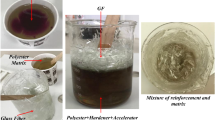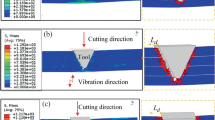Abstract
Cutting parameters and the resulting cutting forces have a great effect on the machinability of materials during the turning process. The effects of cutting parameters on machinability have been examined by many researchers and studies on determination of suitable cutting conditions for various materials are still under investigation. In this study, surface roughness of unidirectional glass-fiber reinforced plastic composite was examined on the basis of cutting parameters such as depth of cut, feed rate, tool geometry, and cutting speed. The surface quality was found to relate closely to the feed rate, cutting speed, and cutting tool.
Similar content being viewed by others
References
Santhanakrishnan G, Krishnamurthy R, Malhotra SK (1989) High-speed steel tool wear studies in machining of glass-fiber reinforced plastics. Wear 132:327
Lubin G (1982) Handbook of composites. Van Nostrand Reinhold, New York, p 625
Inoue H (1987) Zairyo. J Soc Mater Sci 36(402):242
Takeyama H, Lijima N (1988) Machinability of GFRP and applications of ultrasonic machining. Ann CIRP 37:93–97
Santhanakrishnan G, Krishnamurthy R, Malhotra SK (1988) Machinability characteristics of fibre reinforced plastic composites. J Mech Work Technol 17:195–204
Spur G, Wunsch UE (1988) Turning of fiber reinforced plastics. Manuf Rev 1(2):124–129
Kaneeda T (1989) CFRP cutting mechanism. NAMRC XV III:216
Park J (1991) A study on the effects of PCD tool geometry on the machining of graphite epoxy composite material. MSc Thesis. University of Washington, May
Ramulu M, Arola D, Colligan K (1994) Preliminary investigation of effects on the surface integrity of fiber reinforced plastics. Eng Syst Anal ASME PD 64-2:93–101
Lee ES (2001) Precision machining of glass fibre reinforced plastics with respect to tool characteristics. Int J Adv Manuf Technol 17:791–798
Wang XM, Zhang LC (2003) An experimental investigation into the orthogonal cutting of unidirectional fibre reinforced plastics. Int J Mach Tools Manuf 43:1015–1022
Davim JP, Mata F (2005) A new machinability index in turning fiber reinforced plastics. J Mater Process Technol 170(1–2):436–440,
Davim JP, Mata F (2005) Optimisation of surface roughness on turning fibre-reinforced plastics (FRPs) with diamond cutting tools. Int J Adv Manuf Technol 26(4):319–323
Palanikumar K, Karunamoorthy L, Karthiyekan R (2006) Assessment of factors influencing surface roughness on the machining of glass fiber-reinforced polymer composites. Mater Des 27:862–871
Palanikumar K (2006) Modeling and analysis for surface roughness in machining glass fibre reinforced plastics using response surface methodology. Mater Des (in press, available online)
Palanikumar K (2006) Application of Taguchi and response surface methodologies for surface roughness in machining glass fiber reinforced plastics by PCD tooling. Int J Adv Manuf Technol, available online
Palanikumar K (2006) Mathematical model to predict tool wear on the machining of glass fibre reinforced plastic composites. Mater Des (in press, available online)
Davim JP, Mata F (2007) New machinability study of glass fibre reinforced plastics using polycrystalline diamond and cemented carbide (K15) tools. Mater Des 28:1050–1054
Isik B (2005) Effects of cutting parameters to processing performance during orthogonal turning of glassfiber reinforcement plastic composites. PhD Thesis, Marmara University, Turkey
Author information
Authors and Affiliations
Corresponding author
Rights and permissions
About this article
Cite this article
Işık, B. Experimental investigations of surface roughness in orthogonal turning of unidirectional glass-fiber reinforced plastic composites. Int J Adv Manuf Technol 37, 42–48 (2008). https://doi.org/10.1007/s00170-007-0946-7
Received:
Accepted:
Published:
Issue Date:
DOI: https://doi.org/10.1007/s00170-007-0946-7




